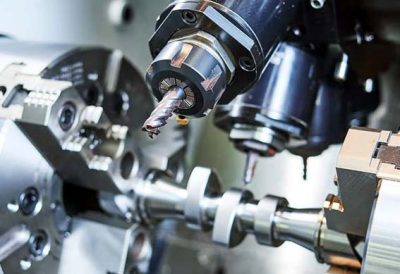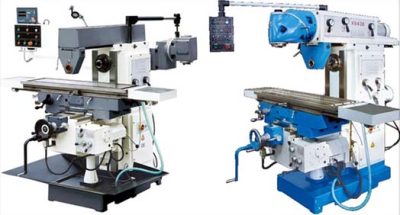Categorie di Prodotto
Tag dei prodotti
messaggi recenti
Classificazione e manutenzione delle fresatrici
La fresatrice è una vasta gamma di macchine utensili. L'aereo (piano orizzontale, piano verticale) può essere lavorato sulla fresatrice; Scanalatura (chiavetta, Scanalatura a T, scanalatura a coda di rondine, eccetera.); Parti di ingranaggi (ingranaggi, alberi scanalati, pignoni); Superficie a spirale (filo, scanalatura a spirale) e varie superfici curve. Inoltre, può anche essere utilizzato per lavorare la superficie e il foro interno del corpo rotante e tagliare il lavoro.
La fresatrice è una vasta gamma di macchine utensili. L'aereo (piano orizzontale, piano verticale) può essere lavorato sulla fresatrice; Scanalatura (chiavetta, Scanalatura a T, scanalatura a coda di rondine, eccetera.); Parti di ingranaggi (ingranaggi, alberi scanalati, pignoni); Superficie a spirale (filo, scanalatura a spirale) e varie superfici curve. Inoltre, può anche essere utilizzato per lavorare la superficie e il foro interno del corpo rotante e tagliare il lavoro. When the milling machine is working, the workpiece is mounted on the worktable or the indexing head and other accessories, and the milling cutter rotates as the main motion, supplemented by the feed motion of the worktable or the milling head, and the workpiece can obtain the required processing surface. Because of the continuous cutting of multi-edge tools, the productivity of the milling machine is high. Simply put, a milling machine is a machine tool that can mill, drill threads, and boring parts.
The main classification of milling machines
Milling machines are distinguished by layout form and scope of application
1. Lifting table milling machine: There are universal type, horizontal type and vertical type, which are mainly used for processing small and medium-sized parts and are the most widely used.
2. Gantry milling machine: Including gantry milling and boring machines, gantry milling and planing machines and double-column milling machines, which are all used to process large parts.
3. Single column milling machine and single arm milling machine: The horizontal milling head of the former can move along the column guide, and the worktable can feed longitudinally;
The latter's end milling head can move horizontally along the cantilever rail, and the cantilever can also be adjusted in height along the column rail. Both are used to process large parts.
4. Milling machine without lifting worktable: There are two types of rectangular worktables and round worktables. It is a medium specification milling machine between the lifting table milling machine and the gantry milling machine. The vertical movement is accomplished by lifting the milling head on the column.
5. Instrument milling machine: a small lifting table milling machine, used for processing instruments and other small parts.
6. Tool milling machine: For mold and tool manufacturing, it is equipped with various accessories such as end milling head, universal angle table and plug. It can also perform drilling, boring and slotting.
7. Other milling machines: Such as keyway milling machines, cam milling machines, crankshaft milling machines, roll journal milling machines and square ingot milling machines. It is a special milling machine manufactured for processing special workpieces.
Milling machines are classified by structure
(1) Desktop milling machine: A small milling machine for milling small parts such as instruments and meters.
(2) Cantilever milling machine: A milling machine with a milling head mounted on a cantilever. The milling machine body is arranged horizontally, the cantilever can generally move vertically along the column guide rail on one side of the bed, and the milling head moves along the cantilever guide rail.
(3) Ram type milling machine: A milling machine with a spindle mounted on a ram.
(4) Gantry milling machine: The milling machine body is arranged horizontally, and the columns and connecting beams on both sides constitute the milling machine of the portal frame. The milling head is installed on the beam and column, and can move along the guide rail. Generalmente, the beam can move vertically along the column guide rail, and the worktable can move longitudinally along the bed guide rail for processing large pieces.
Maintenance of milling machine
XK-1060 Vertical CNC Milling Machine
Routine warranty of milling machine
1. Cleaning of milling machine body and parts, cleaning iron filings and surrounding environment;
2. Check the oil level of each lubricating oil, and it shall not be lower than the oil standard, and add lubricating oil to each part;
3. Cleaners, morsetti, strumenti di misurazione.


Fresatrice Longmen che fresa componenti di grandi dimensioni

Small parts processed by instrument milling machine

Different applications of keyway milling machine and cam milling machine
The maintenance scope of the milling machine
1. Clean and adjust the workbench, screw handle and column inserts;
2. Check and adjust the clutch;
3. Clean the three-way guide rail and oil felt, clean the motor, the inside and outside of the machine tool and accessories;
4. Check the oil circuit and fill each part with lubricating oil;
5. Tighten all screws.
Uno. clean
1. Remove and clean the felt pads of various parts;
2. Wipe the sliding surfaces and guide rail surfaces, wipe the workbench and the horizontal, lift screw, wipe the knife drive mechanism and the knife holder;
3. Wipe all dead corners.
two, lubricating
1. The oil holes are clean and unobstructed and filled with lubricating oil;
2. Add lubricating oil to each guide rail surface, sliding surface and each screw rod;
3. Check the oil tank body and oil level of the transmission mechanism, and add oil to the elevation position.
three, Tighten
1. Check and tighten the pressure plate and inserting screws;
2. Check and tighten the slider fixing screws, the drive mechanism, the handwheel, the workbench bracket screws, and the fork top wire;
3. Check to tighten other parts to loosen the screws.
four, Adjustment
1. Check and adjust the tightness of the belts, pressure plates and inserts;
2. Check and adjust the sliding block and screw rod order.
Fives, Antiseptic
1. Remove the rust of each part and protect the painted surface from collision;
2. Out-of-service, spare equipment guide rail surface, sliding screw hand wheel and other exposed parts that are easy to rust are oiled for corrosion protection.
Contattaci
Aspetto la tua email, ti risponderemo entro 12 ore con le preziose informazioni di cui avevi bisogno.
 English
English العربية
العربية 中文(漢字)
中文(漢字) Čeština
Čeština Dansk
Dansk Nederlands
Nederlands Suomi
Suomi Français
Français Deutsch
Deutsch Italiano
Italiano 日本語
日本語 ಕನ್ನಡ
ಕನ್ನಡ 한국어
한국어 Português
Português Русский
Русский Slovenčina
Slovenčina Español
Español Svenska
Svenska Türkçe
Türkçe




